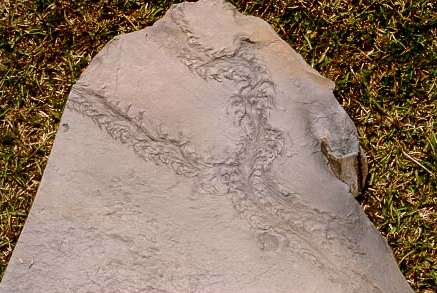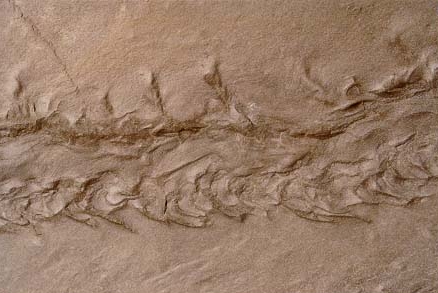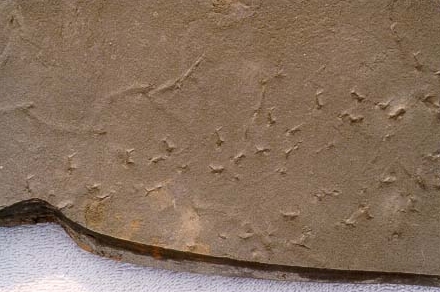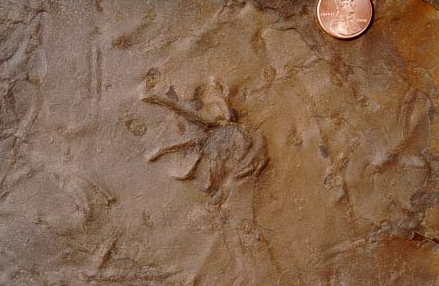Department of Physics and Astronomy
University of Alabama
Tuscaloosa, Alabama
|
It was decided at the March
meeting that the BPS should return to this
mine once again as an organized field trip. As I have noted in previous
reports, this is a site the BPS visited with great success just two
months earlier. The site is rich in footprint fossils of Pennsylvanian
amphibians and other creatures. Although the previous organized visit,
on January 23, occurred on a rather bleak day, it was nothing like the
one today. Rain fell hard all day across most of Alabama and never let
up even for a few minutes. Because of the weather, only six people
turned up for this outing. |  |
| | Figure 1 Unusual tracks of one
or two large creatures that must have been moving in very wet mud. |
| In spite of the weather, several of us still found nice
tracks and
other fossils. I show a few that I picked up here. One large set of
tracks I found was lying at the bottom of a rock pile that had been
thoroughly searched. After the tracks were cleaned of mud, it looks to
me like they are amphibian tracks that were laid down in rather wet
mud. The impressions are wide as the creatures' whole body probably
sloshed in the mud. There are two sets of tracks on the main piece, and
details of one are shown in the close-up. |  |
| | Figure 2 Close-up of
part of the previous specimen, showing likely toe prints flanking the
broad body scrape. |
 | Figure 3 Small
tracks of one or more creatures that could be Bipedes aspodon. |
A much smaller set of tracks I
found in a
different area has small y-shaped prints in a bit of a random pattern.
In Museum Paper No. 9 of the Alabama Museum of Natural History (authors
Aldrich and Jones), a creature that produced similar tracks is known as
Bipedes aspodon. At least two sets of tracks are also present on this
piece. Bipedes aspodon is described by Aldrich and Jones as an animal
with only two toes. Although Aldrich and Jones clearly considered the
creature to be an amphibian, BPS members who found similar tracks felt
they are more likely to be tracks of an arthropod.
|
 | Figure
4 Single
print of Quadropedia prima, a modest-sized amphibian. At this layer,
the track shows five clear toes as well as a pad. |
I
found some other interesting and larger tracks on a large rock on the
well-searched rock piles. I suspected tracks might be inside at a
deeper level in this rock. The rock had interesting deposits or
formations that covered different layers, but it was not clear what
these features might be. After removing many layers of the rock, I did
indeed find four footprints of a modest-sized creature which, according
to Museum Paper No. 9, is an amphibian known as Quadropedia prima.
Aldrich and Jones state that the creature is higher in the scale than
most of the species they illustrated in their article, because it
walked more like later reptiles. They point out the presence of a
distinct pad, which we can see in the pictures I show here. The four
prints could be detected at several different layers, and at least one
of the prints was well-defined at all of the layers. The appearance of
the prints seemed different at different layers, suggesting that some
of the variety in the prints we have been finding at the site is due in
part to the different layers that were exposed. |
| |
| |
Figure
5 Two tracks of the same creature, the one at right being the
same foot as in the previous picture, but the print looks different
because it is at a different level. At this level, only three toes are
seen, with a strong pad.
|
Other
Notes on the Union Chapel Site January 23-March 19, 2000
The Union Chapel Mine was visited many times by BPS
members and guests
between January
23 and March 19. Ashley Allen brought to the February BPS meeting a
huge rock with a set of excellent large amphibian prints. Bruce Relihan
brought to the March BPS meeting a large stump cast of a likely
Lepidodendron. The stump is more than a foot in diameter and tapers
around the edges, as if it were near the bottom of the original trunk.
Bruce related the heroic effort he put into getting the huge fossil by
himself, which involved building a rock ramp to allow him to get it
into his truck. Steve Minkin also brought to the last BPS meeting an
excellent set of modest-sized tracks found by his wife.
All in all, the Union Chapel site elicited such great
interest and
finds that Steve Minkin asked Ed Hooks if the BPS could have a
temporary display case at the Alabama Museum of Natural History in
Tuscaloosa. Ed agreed to this and some of the new Union Chapel pieces
may soon be on display for the public to see!





